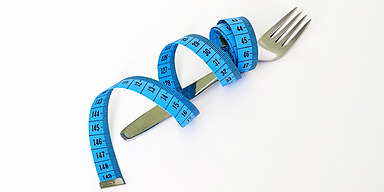Living life with an eating disorder can be a devastating experience and without treatment can be life-threatening.
Eating disorders are psychological conditions with both emotional and physical symptoms. Eating disorders take on a life of their own so that eating, or not eating, becomes the focus of everyday existence. A common misconception about eating disorders is that they only affect women, but the reality is that 15% of people with diagnosed eating disorders are men.
Whether you’re a worried parent, a concerned friend or have suspicions about your own behavior, these are the different eating disorders and the signs to watch out for.
Anorexia Nervosa
Anorexia Nervosa is an extreme lack of food and therefore nutrition and fuel to run the basic functions in the body. If the person in question is below the range of underweight for their height then they are at a major risk. For women, anorexia can cause a complete discontinuation of menstrual periods and increases the risk of heart attack and disease. If a person is skipping meals or making excuses in order to not eat, they may be purposefully restricting themselves to an unhealthy caloric intake.
Anorexia nervosa usually starts at puberty and 90% to 95% of those with anorexia are female. Within 10 years of its onset, 10% of people with anorexia will die from the illness and its complications, including suicide.
Anorexia amounts to self-starvation and includes:
- the need to be very thin along with a fear of being fat;
- a preoccupation with weight and body image;
- a distorted body image;
- feeling overweight no matter how thin;
- obsession with food;
- low self-esteem and feelings of self-worth that are closely tied to body image.
Outward signs can include:
- eating very little, sometimes to the point of starvation;
- limiting the types of foods consumed, becoming more restrictive over time;
- over-exercising, spending more and more time working out;
- using diet pills and laxatives;
- denial of hunger;
- obvious ongoing weight loss that cannot be reasonably explained;
- making frequent comments about feeling fat or overweight;
- avoiding situations that involve food (e.g. mealtimes, social occasions involving food/eating).
As the disorder progresses, health impacts can include:
- slowed heart rate and low blood pressure;
- lethargy, muscle weakness, fainting;
- signs of starvation such as hair loss, lack of menstrual periods, pasty skin, yellowing of the palms or soles of the feet;
- growth of downy hair all over the body to keep the body warm;
- reduced bone density;
- irritability, depression, difficulty concentrating;
- increased risk of heart failure.
Bulimia Nervosa
Bulimia is hard to spot because many people maintain a ‘healthy’ weight but bulimia is still destructive and can lead to a more obvious eating disorder like anorexia or binge eating. Bulimia involves the use of laxatives or induced vomiting in order to purge the food that has just been eaten. Because of the repetitive manner of purging, bulimia creates a huge strain on the digestive system. More common than anorexia, bulimia can involve:
- an ongoing cycle of uncontrollable binge-eating followed by purging;
- forced vomiting and overuse of laxatives, diuretics and diet pills;
- over-exercising, fasting and dieting;
- extreme concern about weight though body weight may remain normal or “yo-yo” up and down;
- self-esteem tied to body image.
Signs of bulimia can include:
- obsessive exercising;
- physical effects from frequent vomiting such as swollen cheeks or jaw, discolored teeth, or hardened, thickened skin on the back of hands;
- evidence of purging, such as frequent trips to the washroom after meals, packaging from laxatives or diuretics in the trash, or signs (smell, traces) of vomit or diarrhea;
- lack of energy;
- rapidly disappearing food supplies or empty packaging from a lot of snack products;
- frequent weight checks;
- reduction of normal activities, including withdrawal from social activities, as the bulimic activities become an intense, consuming interest.
Health impacts of bulimia can include:
- bowel disturbances, constipation;
- inflamed esophagus, possible ruptures;
- heart trouble; and
- oesophageal inflammations, destruction of tooth enamel and electrolyte imbalances.
Note that the most dangerous and worst case scenarios of bulimia can lead to stroke or heart attack.
Binge Eating Disorder
On the opposite side of the spectrum from anorexia, binge eating is an eating disorder that leads to extreme weight gain. Binge eating can be eating too much, too often or too much at once. Like all the other eating disorders, binge eating is connected to depression and anxiety. Some people may use food to deal with anxieties, or as a symptom of depression. Signs of binge eating include eating when full or not hungry and separating one’s self from others shamefully in order to eat.
Binge eating involves:
- frequent episodes of overeating, often in secret, often junk food;
- feeling a loss of control during the binge;
- feelings of guilt, shame or disgust about bingeing.
Note: Binge Eating Disorder does not include the purging seen in bulimia, but it can involve cycles of dieting or fasting.
Health impacts of bingeing can include:
- diabetes;
- high blood pressure;
- joint pain and distress (from carrying extra weight);
- depression;
- heart disease;
- heart failure
- high blood sugar;
- high blood pressure; and
- stroke
References:
- Eating disorders. National Alliance on Mental Illness. Retrieved October 1, 2018 from: https://www.nami.org/Learn-More/Mental-Health-Conditions/Eating-Disorders/Overview.
- Forman SF. Eating disorders: Overview of epidemiology, clinical features, and diagnosis. Retrieved October 1, 2018 from: https://www.uptodate.com/contents/search.
- The American Heart Association’s Diet and Lifestyle Recommendations. American Heart Association. Retrieved October 1\, 2018 from: http://www.heart.org/HEARTORG/HealthyLiving/HealthyEating/Nutrition/The-American-Heart-Associations-Diet-and-Lifestyle-Recommendations_UCM_305855_Article.jsp#.Wuh82Jch3cs.
- Using dietary supplements wisely. National Center for Complementary and Integrative Health. Retrieved October 1, 2018 from: https://nccih.nih.gov/health/supplements/wiseuse.htm.













